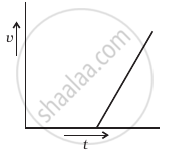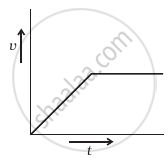Advertisements
Advertisements
प्रश्न
A tall cylinder is filled with viscous oil. A round pebble is dropped from the top with zero initial velocity. From the plot shown in figure, indicate the one that represents the velocity (v) of the pebble as a function of time (t).
विकल्प
उत्तर

Explanation:
In fluids, when the pebble is dropped from the top of a tall cylinder filled with viscous oil, a variable force called viscous force will act which increases with an increase in speed. And at equilibrium this velocity becomes constant, that constant velocity is called terminal velocity.
When the pebble is falling through the viscous oil, the viscous force is F = 6πηrv
Where r is the radius of the pebble, v is instantaneous speed, η is the coefficient of viscosity. As the force is variable, hence acceleration is also variable so the v-t graph will not be a straight line. First velocity increases and then becomes constant known as terminal velocity.
APPEARS IN
संबंधित प्रश्न
A solid sphere falls with a terminal velocity of 20 m s−1 in air. If it is allowed to fall in vacuum,
A metal sphere of radius 'R' and density 'ρ1' is dropped in a liquid of density 'σ' moves with terminal velocity 'v'. Another metal sphere of same radius and density 'ρ2' is dropped in the same liquid, its terminal velocity will be ______.
A drop of radius 1.5 x 10-5 and density 2 x 103 kg/m3 falls through air. The viscosity of air is 1.8 x 10-5 N s/m2. Neglecting buoyancy due to air, the terminal speed of the drop is ____________.
A drop of radius 4 x 10-5 m and density 2.5 x 103 kg/m3 falls through air. The viscosity of air is 1.96 x 10-5 N s/m2 . Neglecting buoyancy due to air, the terminal speed of the drop is ____________.
Two small spherical metal balls, having equal masses, are made from materials of densities `rho_1` and`rho_2 (rho_1 = 8rho_2)` and have radii of 1 mm and 2 mm, respectively, they are made to fall vertically (from rest) in a viscous medium whose coefficient of viscosity equals `eta` and whose density is `0.1rho_2` The ratio of their terminal velocities would be, ____________.
Two rain drops falling through air have radii in the ratio 1 : 2. They will have terminal velocity in the ratio ______.
Two drops of equal size are falling vertically through the air with a constant terminal velocity of 0.15 cm/s. What should be the velocity, if these drops coalesce to form one drop?
A small spherical ball of radius 0.1 mm and density 104 kg m-3 falls freely under gravity through a distance of h before entering a tank of water. If, after entering the water the velocity of the ball does not change and it continues to fall with the same constant velocity inside the water, then the value of h will be ______ m.
(Given g = 10 ms-2, the viscosity of water = 1.0 × 10-5 N-sm-2).
A spherical solid ball of volume V is made up of a material of density ρ1. It is falling through the liquid of density ρ2(ρ2 < ρ1). Assume that, the liquid applies a viscous force on the ball that is proportional to the square of the speed vt, i.e., `["F"_"viscous" = "KV"_"t"^2]`, then the terminal speed of the ball is ______.
(g = acceleration due to gravity)
Two equal drops of water are falling through air with a steady velocity v. If the drops coalesce, the new velocity will be ______.



